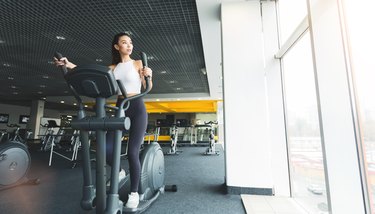
Hop on an elliptical machine regularly, and you'll start to notice several positive health benefits — from toned buttocks and arms to improved heart health. Use an elliptical for glutes and for overall health as well — keeping five things in mind as you glide and sweat.
1. Elliptical Machines Are Versatile
Video of the Day
The elliptical offers a low-impact workout suitable for a variety of fitness levels. Many elliptical machines are equipped with handles that let you move your arms along with your legs. Pump your arms in unison with your lower body, and the elliptical recruits not only glutes, quadriceps and hamstrings, but also biceps, triceps, back and chest. Your abdominals are involved, too, as you brace your core and balance while pedaling your legs.
Video of the Day
Most elliptical machines also let you pedal your legs in reverse. This reverse motion works your calves and hamstring muscles slightly more than the forward movement. As you exercise on an elliptical, you can choose to perform part of the session going forward and part of it in reverse to vary your workout.
You can further choose to alternate days, focusing on forward motion one day and backward on another to target different muscle groups. You can also go hands-free occasionally to focus on added core strength and stability as well as good posture.
Read more: Elliptical Machine Benefits
2. Ellipticals Offer a Treadmill Alternative
Elliptical machines function like a treadmill in that both types of machines will give you an aerobic workout. Ellipticals may offer a few advantages over treadmills, however, depending on your preferences and workout goals.
With a treadmill, one foot must leave the machine's platform as you walk or run. In contrast, on an elliptical machine, both feet remain grounded as you pedal in an "elliptical," oval-like motion. Because your feet never leave the machine, your joints and lower back experience less impact, according to the Arthritis Foundation. When you run or walk, the load on your joints is up to 2.5 times your body weight.
That means every time you pound your feet on the treadmill or the ground, your body must absorb the impact. Over time, the increased load on your ankles, knees, hips and lower back could result in injury. Everyone's body is different, though, and some people don't experience problems with running. For others, the elliptical machine is a better alternative.
3. You Can Cross-Train
If you like to run or you're training for a running race, you might prefer a treadmill. However, the International Sports Sciences Association notes that the elliptical machine is ideal for cross-training. With cross-training, you exercise in a variety of ways instead of doing only one type of exercise day after day. Cross-training can help you improve performance and break through a training plateau in your primary sport, such as running or playing soccer.
Varying your workout through cross-training also reduces the risk of overuse injuries. If you do only one type of exercise, you're continually stressing the same muscles and joints. When you cross-train, you use different muscles and you're less likely to get injured.
Changing up your workout also prevents boredom from performing the same exercise every day. When you're not bored, you're more likely to stick with your workout routine.
4. You Can Lose Weight
If you're looking to lose weight, elliptical machines can help you burn calories and achieve your weight-loss goals. As you exercise, your body uses energy, or calories, either from the carbohydrates, proteins and fats in your food, or from stored body fat. Therefore, to burn calories and lose fat, you must either reduce caloric intake from food or increase physical activity — or both.
The calories burned using an elliptical machine will vary based on your weight. The larger you are, the more calories you need to exert energy. For example, whereas a 125-pound person burns about 270 calories in 30 minutes of elliptical training, a 185-pound person burns about 400 calories.
In addition to elliptical training, focus on a diet filled with a variety of vegetables and fruits, whole grains, lean proteins and fat-free or low-fat dairy and healthy fats, such as avocados. The 2015-2020 Dietary Guidelines for Americans also recommends avoiding added sugars and saturated fats. Aim for less than 2,300 milligrams of sodium per day, and if you drink alcohol, do so in moderation.
5. You’ll Need to Add Weights
Although the elliptical works well for glutes, legs, abdominals and the upper body, you might need to add strength training to your workout routine. To build your glutes and improve overall muscle strength, aim to work out all major muscle groups at least twice a week.
Strength training will help you avoid age-related loss of muscle mass. When you lose muscle, it slows your metabolism and makes it more difficult to stave off fat gain.
There are many different ways to perform strength-training exercises, including dumbbells, barbells, your own body weight and resistance bands. Perform three to five sets of an exercise, with about eight to 12 repetitions per set. You can gradually increase the weight with each set — and in time, you'll be using heavier and heavier weights with each workout.
- Mayo Clinic: "Are Elliptical Machines Better Than Treadmills for Basic Aerobic Workouts?"
- Mayo Clinic: "Counting Calories: Get Back to Weight-Loss Basics"
- Harvard Health Publishing: "Calories Burned in 30 Minutes for People of Three Different Weights"
- Health.gov: "Dietary Guidelines for Americans, 2015-2020: Chapter 1. Key Elements of Healthy Eating Patterns"
- Arthritis Foundation: "Elliptical Machines Go Easy on Your Joints"
- University of Wisconsin Health: "The Impact of Running"
- International Sports Sciences Association: "Understanding and Implementing Cross Training Workouts"
- Cleveland Clinic: "Build Muscles, Lose Weight by Adding Strength Training to Your Workout"